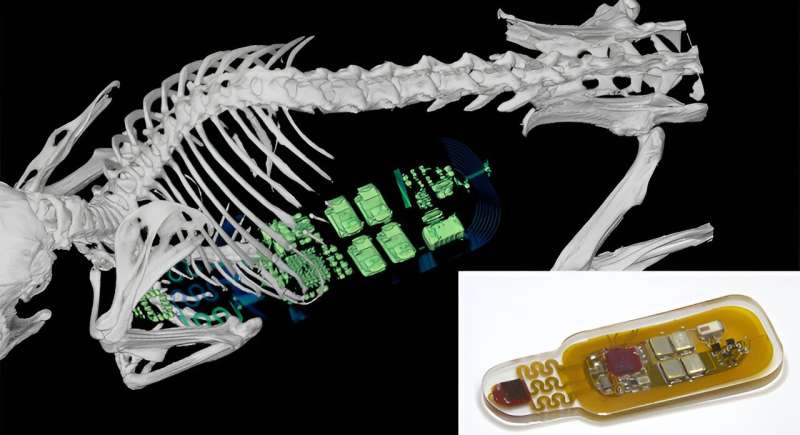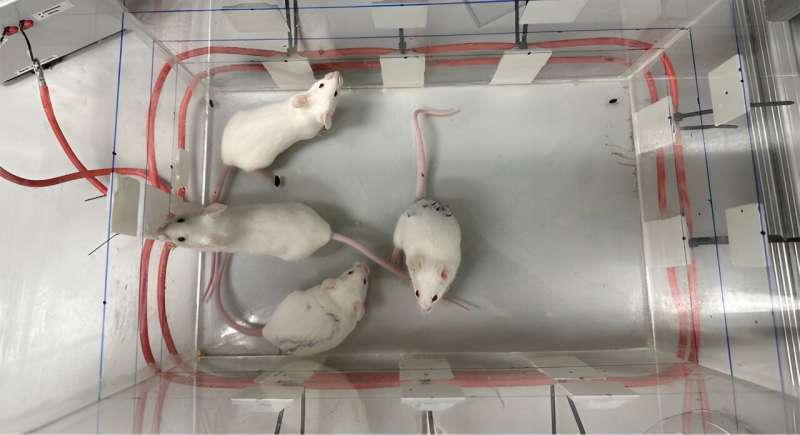Unobtrusive, implantable device could deepen our understanding of behavioral responses


Much of what we know about neurological and psychiatric disorders in humans can be traced back to foundational studies of how animals, such as mice, learn and adapt to various situations. Studying behavioral responses has been enlightening, yet this only tells part of the story.
Behaviors are often accompanied by physiological changes—such as spiking heart rates or fluctuations in body temperature—that can be indicative of disease or response to a drug. But this information has been nearly impossible to collect during behavioral tests in animals without being disruptive. Now, a new device could offer unprecedented insights into the underlying physiology that accompanies specific behaviors observed in mice.
Researchers have developed a wireless, battery-free sensor that, when implanted in mice, was able to gauge body temperature and heart and respiratory rates along with behavioral information. A proof-of-concept study published in Neuron reports a diverse array of previously inaccessible physiological data taken during various behavioral tests, demonstrating the instrument’s broad applicability. The authors suggest the device could unlock numerous avenues of research such as the effects of brain disorders and treatments on sleep.
“The ability to combine physiology readings in concert with behavior has the potential to significantly advance neuroscience and other fields of research,” said study co-author Cameron Good, Ph.D., chief research officer of NeuroLux, Inc. and animal surgery advisor at Northwestern University.
Mouse-tailored tech
Measuring heart rate or checking body temperature may sound straightforward, but with traditional sensors, which require wires to transmit the data and batteries to power the device, retrieving data from small animals during behavioral tests has been challenging.
The bulky equipment can induce anxiety in mice and restrict their movement, putting physiological data out of reach during tests that have the animals sleep, run, swim, or interact with other mice.
A neuroscientist by training, Good teamed up with John Rogers, Ph.D., a professor of biomedical engineering at Northwestern University, to develop a solution. Together the researchers designed and built a lightweight wireless device, small enough to be implanted beneath the skin of mice without obstructing movement or causing significant irritation.
For power, the device relies on a process called inductive coupling, where an external source transmits radio waves that generate an electrical current within the system. The device also features a wireless communication module commonly used in smart devices, allowing it to continuously transmit data to a computer.
The instrument houses a miniature temperature sensor and a high-performance accelerometer to pick up on vibrations in the body generated by different biological processes—like a beating heart, breathing, and body movement. Because these processes can all occur simultaneously, the system must tell the different kinds of vibrations apart.

“The saving grace here is that the vibrations associated with each activity cover a distinct range of frequencies. Cardiac cycles produce much more spiky, high-frequency events than respiratory cycles,” Rogers, a co-author of the study, said.
Because of these unique vibrational characteristics, the researchers were able to develop machine learning algorithms to correlate different components of the raw data to specific sources. In addition to identifying breathing and heartbeats, the device could also distinguish physical activities, eliminating the need for researchers to manually document behavioral states while watching potentially hours of video recordings.
Exploring the possibilities
In the study, authors implanted untethered devices in the abdomen of mice near the heart. To demonstrate some of their technology’s possible applications, they ran the mice through a broad spectrum of experiments. These included a swimming test commonly used in depression and anxiety studies, tests for motor function and cognition, as well as several social interaction studies.
Throughout the experiments, the device allowed the authors to obtain physiological data in real time and glean details that would have otherwise been inaccessible. For example, the team found that when witnessing a physical conflict between two other mice, heart rates spiked in male mice but stayed on an even keel in female mice.
In another test, the authors used the device to automatically track both physiological data and behavioral states, including walking, resting, and grooming, as mice freely roamed their enclosures over 17 days. The major implication of this experiment, Good explained, was their technology’s potential in sleep research, an arena where physiological data in mice has been highly pursued to gain a better understanding of conditions such as sleep apnea.
Despite the promising findings of their study, the authors are working to extend the impact of this work.
“We’ve already shipped out dozens of devices to people who’ve requested the technology for multi-animal studies, sleep-wake studies, and other kinds that were previously impossible,” Rogers said.
In addition to neuroscience, the researchers foresee applications in cardiovascular research, drug development, and many other fields.
“This study is a great example of how scientists and engineers can each bring unique but complementary skillsets to the table to solve complex problems in biomedical research,” said Tiffani Lash, Ph.D., NIBIB program director in the Division of Health Informatics Technologies.
More information:
Wei Ouyang et al, An implantable device for wireless monitoring of diverse physio-behavioral characteristics in freely behaving small animals and interacting groups, Neuron (2024). DOI: 10.1016/j.neuron.2024.02.020
Citation:
Unobtrusive, implantable device could deepen our understanding of behavioral responses (2024, May 10)
retrieved 10 May 2024
from https://medicalxpress.com/news/2024-05-unobtrusive-implantable-device-deepen-behavioral.html
This document is subject to copyright. Apart from any fair dealing for the purpose of private study or research, no
part may be reproduced without the written permission. The content is provided for information purposes only.





